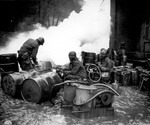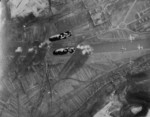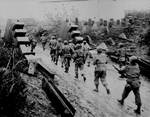Advance to the Rhine
Contributor: C. Peter Chen
ww2dbase"The German is now licked", said Alan Brooke to Dwight Eisenhower early in 1945, after Adolf Hitler's gamble in the Ardennes Offensive (Battle of the Bulge) had failed. "It is merely a question of when he chooses to quit." Before Eisenhower ordered his troops across Germany's traditional boundary, he gave the order to clear the area west of the Rhine River (and south of the Maas and Waal rivers in the Netherlands). The armies involved were, from north to south:
- Canadian First and British Second Armies, attacking the northern section west of the Arnhem-Wesel region.
- American Ninth Army, attacking the area west of the Duisburg-Düsseldorf region.
- American First Army, attacking Cologne-Bonn region.
- American Third Army, attacking the wide central Rhine region, including the Saar Basin.
- American Seventh Army, attacking the Saar Basin.
- French First Army, attacking the southern area from Strasbourg to near the Austrian border.
ww2dbaseIn the extreme south of this operation, the French First Army launched their offensive against Colmar on 20 Jan 1945. Fierce German resistance and bad weather slowed the progress of the French troops. To reinforce the French, the XXI Corps under the command of Major General Frank Milburn came into the region, which included three American infantry divisions and one French armored division. The Germans surrendered Colmar on 3 Feb, and within a week all German forces in the region retreated across the Rhine. German casualties reached the count of 22,000 near Colmar.
ww2dbaseThe northern borders of German were heavily defended with the best troops that were available to Germany, including the First Paratroop Army. The dams along the Roer also provided the German forces additional advantage in that they could control of the flow of the water by opening or closing the dams based on reported Allied movements. British General Bernard Montgomery launched his Canadian troops first, under the command of General H.D.G Crerar, on 10 Feb 1945 into the muddy flooded region near the Netherlands-Germany border. Slightly to the south, the American troops that could have relieved some pressure off of the bogged-down Canadian troops were sitting in frustration as the Roer was flooded by German troops, making an American advance impossible. The opportunity finally came two weeks later, launching the offensive on 23 Feb. The American troops maneuvered through difficult terrain caused by destructive Allied bombing and shelling, often needing armored bulldozers to clear the way so that Allied armor could continue their advance. The American Ninth Army finally met up with the Canadian and British troops on 3 Mar, driving the Germans back to their defensive positions at bridges on the Rhine.
ww2dbasePart of the difficult terrain formed by bombing encountered by the Ninth Army was caused by Operation Clarion, an operation launched on 22 Feb 1945 with the goal of wiping out all forms of transportation still available to the German troops at this stage of the war. In 24 hours, nearly 9,000 aircraft were sent from Britain, France, Belgium, and the Netherlands in a coordinated attack over 250,000 square miles of German territory. The primary targets were roads, bridges, crossroad towns, ports, and railroads. The Luftwaffe, previously hurt and currently overwhelmed, offered little organized resistance to the Allied operation. "It was a most imaginative and successful operation and stood as one of the highlights in the long air campaign to destroy the German warmaking power", commented Dwight Eisenhower.
ww2dbaseOn the same day Lieutenant General William Simpson's Ninth Army launched their attacks in the northern sector, Omar Bradley ordered the First and Third armies to strike the central sector. The American VII Corps reached the outskirts of Cologne on 5 Mar, completely surprising the hastily trained German defenders. Cologne fell under American control two days later. The unexpected quick capture of Cologne gave Eisenhower some breathing room in that should any nearby sectors run into difficulties, the VII Corps could spare a couple of divisions as reserve or reinforcements.
ww2dbaseThe opportunity to use the reserves came almost immediately. As Major General Courtney Hodges' III and V Corps reached the Rhine near Remagen, their rapid advances completely surprised the German troops, and in this surprise they had failed to destroy the Ludendorff Bridge as the other German units had done to the other bridges on the Rhine as the Allied troops drew near. Without hesitation, the 9th Armored Division of the III Corps crossed the bridge and established a defensive perimeter. A small charge exploded under the bridge, damaging some of its understructure, but the bridge remained in tact. Knowing that he had no orders to cross the Rhine just yet, Bradley cautiously reported the situation back to Eisenhower, who recalled:
ww2dbaseWith Eisenhower's blessing, Bradley ordered four divisions to cross the bridge near Remagen. From the north, Eisenhower sent entire divisions from the Cologne area to Remagen. "That was one of my happy moments in the war", Eisenhower commented in 1948. Within two days the bridgehead area was expanded three miles into German territory. Even though on 17 Mar German long-range artillery fire caused the previously damaged Ludendorff Bridge to collapse (recall the small charge that caused structural damage when the bridge was initially secured), by this time a large number of American troops and equipment had already crossed the river, and enough temporary bridges were established in the region to supply these troops.
ww2dbaseDuring the action on the west bank of the Rhine, a major logistical operation was underway to transport Canadian and British troops from the Mediterranean region to the 21st Army Group in western Europe. The goal, as stated by Eisenhower's headquarters, was "to build up the maximum possible strength on the Western Front to seek a decision in that theatre". The bulk of the troops transferred during Operation Goldflake landed at the port city of Marseille and travelled across France on the vast network of roads and railroads. One achievement to be noted with this operation was that the large number of troops travelled across the country of France without disrupting supply runs to the front lines. Experienced logistical staff of the Allies contributed greatly to this achievement; Eisenhower commended those who were responsible in the planning of this operation, stating that
ww2dbasePolitically, it also appeased the Canadian leaders, who wished that at this stage all Canadian troops involved in Europe could serve under one single chain-of-command. As all Canadians serving in Europe came under the command of H.D.G. Crerar under the flag of the First Canadian Army, he emotionally announced to his troops that "now that we are all together, let us all speed to the victory in no uncertain manner".
ww2dbaseA little to the south, the Third Army secured both banks of the Moselle River. The northern component of the Third Army reached the Rhine on 10 Mar, while the southern arm attacked the Saar Basin simultaneously with the American Seventh Army to the south. The German defense at the Saar Basin held on valiantly, but to little effectiveness. Instead of sacrificing this region and withdrawing the troops across the Rhine where natural barriers could have provided advantages in defense, Hitler ordered that the ground was to be held at all costs. And the costs were indeed high. On 15 Mar the Seventh Army attacked, and the Third Army launched a simultaneous attack from the north in the direction of Worms. This southward move by the Third Army was not expected by the German commanders, who thought they would attempt to penetrate the Rhine defenses via the breach at Remagen. Several days later, the French First Army which had secured the Colmar region earlier moved north to assist in the Saar Basin. The region was secured on 23 Mar.
ww2dbaseOn 25 Mar 1945, all significant German resistance on the western banks of the Rhine ceased.
ww2dbaseWhat was impressive with the operations to secure the western bank of the Rhine was not the crushing Allied maneuvers, but rather how they were conducted. The coordination between the armies of two major powers and other nations were as seamless as it could be consider their differing philosophies and goals. Even within the American salient, the fluidity of the army components, as demonstrated by the quickness to shift manpower from the VII Corps at Cologne to the III Corps near Remagen, proved Hitler wrong of what the German dictator thought of the armies of a democracy. Hitler, as recently as the Ardennes Offensive, thought that Eisenhower was nothing more than a puppet of Winston Churchill and Franklin Roosevelt, reporting every move back to Washington and London. Unlike Hitler's thoughts, Eisenhower at the frontlines was able to make quick decisions on the field to take advantage of even the small windows of opportunities that presented themselves during the action. "Happening to be on the spot at the moment, I authorized appropriate boundary adjustments, specifying particularly close interarmy liaison", Eisenhower recalled. "This involved also the transfer of an armored division from the Seventh to the Third Army. The insignificance of this slight change illustrates the accuracy with which staffs had calculated the probabilities."
ww2dbaseThis advance also saw the start of a new problem: prisoners. At this stage of the war, the Allied forces were encountered with over 10,000 prisoners of war each day. This problem eventually turned out to be yet another Allied achievement that attributed to the superb organization skills of the logistics officers, who processed these prisoners efficiently without disrupting the frontline combat.
ww2dbaseSources: Canadian Military Headquarters Historical Section Report No 181, Crusade in Europe.
Last Major Update: Oct 2005
Advance to the Rhine Interactive Map
Photographs
 |  |  |  |
Maps
 |  |  |  |
Advance to the Rhine Timeline
| 2 Nov 1944 | In accordance with Dwight Eisenhower's plan, Bernard Montgomery ordered a complete redeployment of his Army Group in Europe. First Canadian Army now assumed responsibility for the front from the sea to the Reichsward near Kleve in Germany, whilst Second British Army was ordered to clear the Germans west of the Maas River from the huge pocket between Venray and Roermond in the Netherlands, and then to take over the American front north of Geilenkirchen in Germany known as the Heinberg Salientl. |
| 13 Nov 1944 | General Philippe LeClerc's Free French troops attacked to the Upper Rhine out of Alsace, France. |
| 21 Nov 1944 | The French 1st Corps captured the city of Belfort in the Vosges region, but the Germans clung so tenaciously to defences beyond the city that it would not be until 25 November 1944 that the French advance could be resumed. |
| 14 Jan 1945 | Operation Blackcock: British forces cleared the Roer Triangle in Germany, which was known for dams that powered the German industry. |
| 29 Jan 1945 | Allied troops captured Oberhausen, Germany in the Rhine river basin. |
| 1 Feb 1945 | US First Army captured Remscheid in Germany, east of Düsseldorf. On the same day, US Seventh Army reached the Moder River and the Siegfried Line/Westwall. |
| 2 Feb 1945 | French troops captured Colmar, France. |
| 9 Feb 1945 | British and Canadian troops forced their way through a main Siegfried Line/Westwall defensive zone. Meanwhile, half of German 19.Armee was evacuated back into Germany before the final Rhine River bridge in the Colmar Pocket in France was blown. |
| 12 Feb 1945 | British and Canadian forces captured Kleve, Germany. |
| 14 Feb 1945 | British and Canadian troops reached the Rhine River northwest of Duisberg, Germany. |
| 17 Feb 1945 | US Third Army penetrated the Siegfried Line/Westwall and launched massive assault into German territory. |
| 19 Feb 1945 | Units of the US 8th Division began encircling German troops trapped within the Siegfried Line/Westwall. |
| 20 Feb 1945 | George Patton wrote to Omar Bradley, urging Bradley to convince Dwight Eisenhower to allow Bradley's army group to attack aggressively toward the Rhine River. |
| 25 Feb 1945 | Omar Bradley gave George Patton the authority to make advances toward the Rhine River. |
| 28 Feb 1945 | US Ninth Army achieved breakthrough near Erkelenz, Germany. |
| 1 Mar 1945 | US Ninth Army captured cities of München-Gladback and Rheydt in Germany. On the same day, Dwight Eisenhower approved the commencement of Operation Lumberjack. |
| 2 Mar 1945 | Elements of US Ninth Army reached the Rhine River at Neuss, Germany. To the north US Third Army captures Trier, Germany. |
| 3 Mar 1945 | Canadian troops captured Xanten, Germany while US First Army captured Krefeld, Germany. |
| 5 Mar 1945 | Patrols from US First Army reached outskirts of Köln, Germany. |
| 6 Mar 1945 | US Third Army reached the Rhine River near Koblenz, Germany, while US First Army captured Köln. |
| 7 Mar 1945 | US 9th Armored Division unexpectedly captured Rhine River bridge and formed a bridgehead on the east side of the river at Remagen, Germany. |
| 8 Mar 1945 | In Germany, US troops entered Bonn while British and Canadian troops entered Xanten. |
| 9 Mar 1945 | US Third Army captured Andernach, Germany. |
| 10 Mar 1945 | The Germans evacuated Wesel as US Third Army captured Bonn. |
| 11 Mar 1945 | US Third Army captured Kochem, Germany. |
| 12 Mar 1945 | US Third Army crossed Moselle River near Koblenz, Germany. |
| 13 Mar 1945 | In Operation Undertone, US 3rd and 7th Armies advanced toward Rhine River in Germany. |
| 15 Mar 1945 | US First Army was unable to further expand the Remagen bridgehead in Germany due to enemy resistance. |
| 17 Mar 1945 | The Ludendorff Bridge at Remagen, Germany, which had served the Allies so well, collapsed after repeated being bombed by German Ar 234 jet bombers. Twenty-eight American engineers trying to strengthen the structure were swept away to their deaths. Meanwhile, US Third Army captured Koblenz, Germany about 15 miles to the southeast. |
| 18 Mar 1945 | US Third Army captured Boppard, Germany. |
| 19 Mar 1945 | US Seventh Army captured Worms, Germany. |
| 20 Mar 1945 | US Seventh Army captured Saarbrücken, Germany while the US Third Army reached Mainz, Germany. |
| 21 Mar 1945 | US First Army advanced toward Siegburg, Germany. |
Você gostou deste artigo ou achou este artigo útil? Se sim, considere nos apoiar no Patreon. Mesmo USD $1 por mês já vai longe! Obrigado. Por favor, ajude-nos a espalhar a palavra: Fique atualizado com WW2DB: |
Visitor Submitted Comments
14 Jan 2020 03:08:28 AM
very informative, thank you!
All visitor submitted comments are opinions of those making the submissions and do not reflect views of WW2DB.
» Bennett, Donald
» Bradley, Omar
» Crerar, Henry
» de Hautecloque, Philippe
» de Lattre de Tassigny, Jean
» Devers, Jacob
» Hobart, Percy
» Hodges, Courtney
» Simpson, William
Locations:
» France
» Germany
» Netherlands
Related Book:
» Patton, Montgomery, Rommel: Masters of War
- » 1,167 biographies
- » 337 events
- » 44,617 timeline entries
- » 1,244 ships
- » 350 aircraft models
- » 207 vehicle models
- » 376 weapon models
- » 123 historical documents
- » 261 facilities
- » 470 book reviews
- » 28,514 photos
- » 365 maps
Winston Churchill, 1935
Por favor, considere nos apoiar no Patreon. Mesmo R$1 por mês já faz uma grande diferença. Obrigado!
Ou, por favor, nos apoie adquirindo alguns produtos do WW2DB na TeeSpring. Obrigado!
20 Mar 2015 03:09:49 PM
mio zio terreni bruno era prigioniero in campo di concentramento a Mainz.
dichiarato morto il 5 marzo 1945.
non si conosce la posizione tombale.